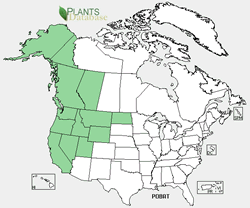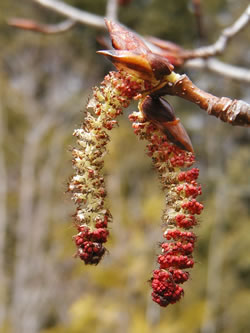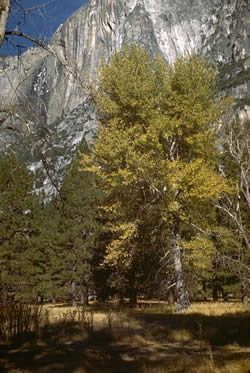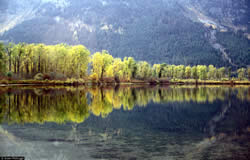Plant of the Week
 Populus balsamifera ssp. trichocarpa range map. USDA PLANTS Database.
Populus balsamifera ssp. trichocarpa range map. USDA PLANTS Database.
 Black cottonwood catkins. Photo by Linda Swartz.
Black cottonwood catkins. Photo by Linda Swartz.
 Black cottonwood. Photo by Charles Webber, California Academy of Science.
Black cottonwood. Photo by Charles Webber, California Academy of Science.
Black Cottonwood (Populus balsamifera L. ssp. trichocarpa (Torr. & Gray ex Hook.) Brayshaw)
By Forest Jay Gauna
Populus balsamifera ssp. trichocarpa is a large cottonwood tree of the western United States. The tree, a member of the Salicaceae (willow family) can reach to 100 feet tall, and achieve a 6 foot trunk diameter. The bark is rough and dark-colored, thus “black cottonwood”. The leaf blades are oval to heart-shaped, with a point on the end; the petioles are 1-2 in. long; look for the pair of glands where the petiole joins the blade. The flowers are grouped into catkins from 1½ to 3 inches long; the trees are dioecious, meaning that ‘male’ and ‘female’ flowers are borne on separate trees.
Although the flowers are inconspicuous,this species is well known for its fuzzy fruits, which during spring and early summer float down from the trees, creating the appearance of a light warm-season snowfall. The trees are fast-growing taking 30-75 years to reach maturity. They inhabit riparian areas, especially along streams. Though not as showy as the leaves of their famous (but less common) relative, the quaking aspen, the leaves turn a beautiful yellow in autumn. During spring and summer, the light green leaves of the tall trees often indicate a source of water in the deserts the Great Basin or Modoc Plateau.
Populus is the Latin name for poplar; balsamifera (“balsam-bearing”) refers to the resinous substance in the buds of the tree, thought to resemble balsam. Balsam is a term for various plant saps with a pleasing odor. Medicines and perfumes were made from balsam in Europe, and it plays a role in Christian rituals. The balsam used by churches is often derived from another subspecies, P. balsamifera ssp. balsamifera. Native Americans and herbal products companies use the resin for medicinal purposes as well, particularly for respiratory ailments. Trichocarpa means “hairy-fruited,” referring to the cottony fluff that helps disperse the minute seeds for long distances.
The Spanish name for cottonwoods is “álamo,” leading the conclusion that the proper Spanish name for this tree is “álamo negro.” This name has lent itself to some famous places in America, such as the Alamo in San Antonio, site of a famous battle for Texan independence, as well as Los Alamos, New Mexico, site of American nuclear laboratories. The name of another New Mexican town, Alamogordo, means “the fat cottonwood tree.”
Economic uses of the black cottonwood include course lumber and the manufacture of wood products such as paper. It is known as a good light wood. The wood is also used for fuel. The resin is used in medicine and perfume.


